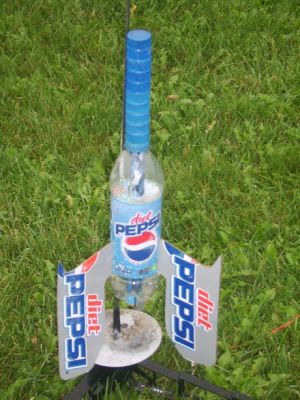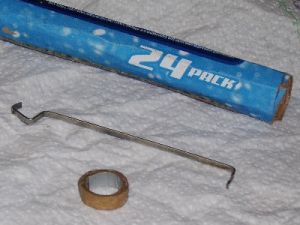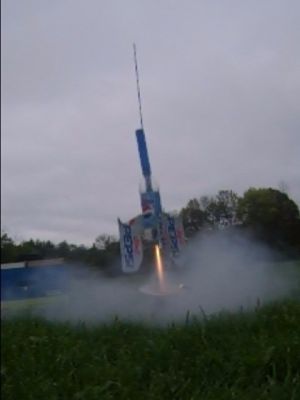Scratch Recycled Pepsi Concept Rocket Original Design / Scratch Built
Scratch - Recycled Pepsi Concept Rocket {Scratch}
Contributed by John Partridge
 Brief:
Brief:
When I considered the idea of building a rocket from recycled household trash, I immediately thought of building one entirely out of Pepsi products. Pepsi bottles look rocket-like so I began to consider how to build it. First I collected raw materials for the project (there is no shortage of raw materials in our house).
Construction:
The stuffer tube and engine block were made from cardboard from the cartons and so were the fins. On the advise of a friend from The Rocketry Forum, I made the engine hook from an old windshield wiper. I couldn't find anything with a Pepsi logo on it for a parachute so I used a Hobby Lobby bag instead.
The stuffer tube assembly with centering rings were also cut from cartons. Finally, the rocket was put on the pad.


Flight and Recovery:
With all the layers I needed to make the centering rings and the fins rigid as well as the extra nose weight I needed to have any chance at a stable flight, I knew my weight was dangerously high for an 18mm motor. My simulations said that it would just barely make the minimum speed off the launch rod and would only fly about 200ft on a C5. The recommended delay was 2.5 seconds so I used a C5-3 (or so I thought). I decided to fly it for the first time alone without my kids because I wasn't certain of how stable it would be but it came off the pad nicely. It rolled a little and arced into the wind but seemed fairly stable and made a little altitude. Then it headed straight for the ground. It turns out that in my haste to launch this rocket before some threatening rain, I misread the label on the motor and used a C6-5 instead. The deployment charge fired well after the rocket impacted the ground.


Summary:
The wings sheared off, the nose cone splintered and spread itself over more than 20 feet in either direction. The shock cord burned through and the engine block seems to have sheared off as well. This was a fun build and cost me nothing except a bunch of epoxy. I learned a lot and may well try this again over the winter. Next time I will be using through the wall fin construction, an internal structure of some kind for the nose cone stack, and a 24mm motor. It may even be a cluster...
Sponsored Ads
 |
 |











